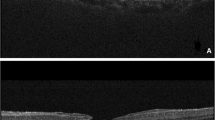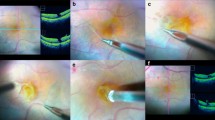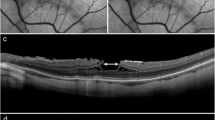Abstract
Purpose
To assess morphological and functional changes of lamellar macular holes and pseudoholes with or without vitrectomy and membrane peeling with at least 5 years follow-up.
Methods
Retrospective study of 73 eyes with lamellar macular hole (LH, n = 28), macular pseudohole (PH, n = 31), and pseudohole with cleaved edges (cleavedPH, n = 14). Forty-six eyes were merely observed without vitreoretinal intervention (observation group), and 27 eyes underwent vitrectomy with membrane peeling (vitrectomy group). Outcome measures were best corrected visual acuity (BCVA) and morphological retinal parameters evaluated with optical coherence tomography (TD-OCT and SD-OCT).
Results
Mean follow-up was 8.3 years (5–12); mean age was 67 years (46–84). In the observation group, median BCVA (logMAR) at first exam was 0.2 (LH), 0.1 (PH), 0.2 (cleavedPH) and at last exam 0.3 (LH, p = 0.02), 0.2 (PH), 0.15 (cleavedPH). In the vitrectomy group, median BCVA at first exam was 0.4 (LH), 0.3 (PH), 0.25 (cleavedPH); before vitrectomy BCVA was 0.5 (LH), 0.35 (PH), 0.35 (cleavedPH); and at last exam BCVA increased to 0.3 (LH), 0.2 (PH, p < 0.05), 0.1 (cleavedPH, p < 0.05). At last exam, BCVA of LH was significantly worse compared to PH and cleavedPH. In the observation group, 6 of 29 eyes with PH or cleavedPH showed a spontaneous resolution of the epiretinal membrane with improvement of the foveal contour. Nine of 16 eyes with LH and 2/20 eyes with PH presented lamellar hole-associated epiretinal proliferation (LHEP) in SD-OCT.
Conclusions
LH, PH, and cleavedPH are often stable over a very long time. LH tends to worse visual function compared to PH and cleavedPH. A spontaneous separation of epiretinal membranes in the long-term is not uncommon. Vitreoretinal intervention should be considered in cases with significant visual loss or functional and morphological progression.






Similar content being viewed by others
References
Duker JS, Kaiser PK, Binder S et al (2013) The international vitreomacular traction study group classification of vitreomacular adhesion, traction, and macular hole. Ophthalmology 120:2611–2619
Gaudric A, Aloulou Y, Tadayoni R, Massin P (2013) Macular pseudoholes with lamellar cleavage of their edge remain pseudoholes. Am J Ophthalmol 155:733–742
Figueroa MS, Noval S, Contreras I (2011) Macular structure on optical coherence tomography after lamellar macular hole surgery and its correlation with visual outcome. Can J Ophthalmol 46:491–497
Pang CE, Spaide RF, Freund KB (2015) Comparing functional and morphologic characteristics of lamellar macular holes with and without lamellar hole-associated epiretinal proliferation. Retina 35:720–726
García-Fernández M, Navarro JC, Sanz AF-V, Castaño CG (2012) Long-term evolution of idiopathic lamellar macular holes and macular pseudoholes. Can J Ophthalmol 47:442–447
Witkin AJ, Ko TH, Fujimoto JG et al (2006) Redefining lamellar holes and the vitreomacular interface: an ultrahigh-resolution optical coherence tomography study. Ophthalmology 113:388–397
dell’Omo R, Virgili G, Rizzo S et al (2017) Role of lamellar hole-associated epiretinal proliferation in lamellar macular holes. Am J Ophthalmol 175:16–29
Pang CE, Spaide RF, Freund KB (2014) Epiretinal proliferation seen in association with lamellar macular holes: a distinct clinical entity. Retina 34:1513–1523
Chen JC, Lee LR (2008) Clinical spectrum of lamellar macular defects including pseudoholes and pseudocysts defined by optical coherence tomography. Br J Ophthalmol 92:1342–1346
Michalewski J, Michalewska Z, Dzięgielewski K, Nawrocki J (2011) Evolution from macular pseudohole to lamellar macular hole—spectral domain OCT study. Graefes Arch Clin Exp Ophthalmol 249:175–178
Theodossiadis PG, Grigoropoulos VG, Emfietzoglou I et al (2012) Spontaneous closure of lamellar macular holes studied by optical coherence tomography. Acta Ophthalmol 90:96–98
Compera D, Schumann RG, Cereda MG et al (2017) Progression of lamellar hole-associated epiretinal proliferation and retinal changes during long-term follow-up. Br J Ophthalmol. https://doi.org/10.1136/bjophthalmol-2016-310128
Govetto A, Dacquay Y, Farajzadeh M et al (2016) Lamellar macular hole: two distinct clinical entities? Am J Ophthalmol 164:99–109
Lai T-T, Chen S-N, Yang C-M (2016) Epiretinal proliferation in lamellar macular holes and full-thickness macular holes: clinical and surgical findings. Graefes Arch Clin Exp Ophthalmol 254:629–638
Compera D, Entchev E, Haritoglou C et al (2015) Lamellar hole-associated epiretinal proliferation in comparison to epiretinal membranes of macular pseudoholes. Am J Ophthalmol 160:373–384
Pang CE, Maberley DA, Freund KB et al (2016) Lamellar hole-associated epiretinal proliferation: a clinicopathologic correlation. Retina 36:1408–1412
Schumann RG, Compera D, Schaumberger MM et al (2015) Epiretinal membrane characteristics correlate with photoreceptor layer defects in lamellar macular holes and macular pseudoholes. Retina 35:727–735
Theodossiadis PG, Grigoropoulos VG, Emfietzoglou I et al (2009) Evolution of lamellar macular hole studied by optical coherence tomography. Graefes Arch Clin Exp Ophthalmol 247:13–20
Ko J, Kim GA, Lee SC et al (2016) Surgical outcomes of lamellar macular holes with and without lamellar hole-associated epiretinal proliferation. Acta Ophthalmol 95(3):e221–e226. https://doi.org/10.1111/aos.13245
Lee SJ, Jang SY, Moon D et al (2012) Long-term surgical outcomes after vitrectomy for symptomatic lamellar macular holes. Retina 32:1743–1748
Bottoni F, Deiro AP, Giani A et al (2013) The natural history of lamellar macular holes: a spectral domain optical coherence tomography study. Graefes Arch Clin Exp Ophthalmol 251:467–475
Meyer CH, Rodrigues EB, Mennel S et al (2004) Spontaneous separation of epiretinal membrane in young subjects: personal observations and review of the literature. Graefes Arch Clin Exp Ophthalmol 242:977–985
Nomoto H, Matsumoto C, Arimura E et al (2013) Quantification of changes in metamorphopsia and retinal contraction in eyes with spontaneous separation of idiopathic epiretinal membrane. Eye Lond Engl 27:924–930
Andreev AN, Bushuev AV, Svetozarskiy SN (2016) A case of secondary epiretinal membrane spontaneous release. Case Rep Ophthalmol Med 2016:4925763. https://doi.org/10.1155/2016/4925763
Yang HS, Hong JW, Kim YJ et al (2014) Characteristics of spontaneous idiopathic epiretinal membrane separation in spectral domain optical coherence tomography. Retina 34:2079–2087
Morel C, Ameline B, Guiberteau B, Laroche L (2000) Spontaneously favorable course of an epiretinal membrane. J Fr Ophtalmol 23:897–900
Schadlu R, Apte RS (2007) Spontaneous resolution of an inflammation-associated epiretinal membrane with previously documented posterior vitreous detachment. Br J Ophthalmol 91:1252–1253
Kolomeyer AM, Schwartz DM (2013) Spontaneous epiretinal membrane separation. Oman J Ophthalmol 6:56–57
Greven CM, Slusher MM, Weaver RG (1988) Epiretinal membrane release and posterior vitreous detachment. Ophthalmology 95:902–905
Acknowledgments
We thank Jürgen Hedderich from the Institute of Medical Informatics and Statistics, University Medical Center Schleswig-Holstein, Kiel, Germany for his valuable help with the statistical calculations.
Author information
Authors and Affiliations
Corresponding author
Ethics declarations
Conflict of interest
The authors declare that they have no conflict of interest.
Ethical approval
All procedures performed in studies involving human participants were in accordance with the ethical standards of the institutional research committee (ethics committee of Christian-Albrechts-University Kiel) and with the 1964 Helsinki declaration and its later amendments or comparable ethical standards.
Informed consent
Informed consent was obtained from all individual participants included in the study.
Rights and permissions
About this article
Cite this article
Purtskhvanidze, K., Balken, L., Hamann, T. et al. Long-term follow-up of lamellar macular holes and pseudoholes over at least 5 years. Graefes Arch Clin Exp Ophthalmol 256, 1067–1078 (2018). https://doi.org/10.1007/s00417-018-3972-2
Received:
Revised:
Accepted:
Published:
Issue Date:
DOI: https://doi.org/10.1007/s00417-018-3972-2




